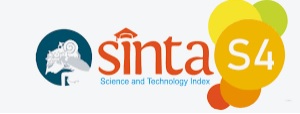Model Perencanaan Bidang Minat Bagi Siswa SMA Berbasis Algoritma Subtractive Clustering
Abstract
Keywords: Â Specialization in High School, Hard Classification Algorithm, Subtractive Clustering Algorithms
References
Departemen Pendidikan Nasional, 2004, Panduan Penilaian Penjurusan Kenaikan Kelas dan Pindah Sekolah, Direktorat Pendidikan Menengah Umum, Jakarta.
Sudaryanto, E., 2007, Pengaruh Minat Belajar dan Penjurusan Terhadap Prestasi Belajar Siswa di SMK Katolik ST Lois Randublatung, Journal Bunda Muliah, Vol. 3 No. 2, Hal. 40-51
Aritonang, K.T., 2008, Minat dan Motivasi dalam Meningkatkan Hasil Belajar Siswa, Jurnal Pendidikan Penabur, No. 10 Tahun ke 7, Hal.11-21
Bahar, Wahono, R.S., 2011, Penentuan Jurusan di SMA dengan Algoritma Fuzzy C-Means, Progresif, Vol. 7 No. 1, Hal. 7-15
Hermanto, N., 2012, Sistem Pendukung Keputusan Menggunakan Metode Simple Additive Weigh Untuk Menentukan Jurusan Pada SMK Bakti Purwokerto, Prosiding pada Seminar Nasional Teknologi Informasi & Komunikasi Terapan, Semarang
Asri, Y., 2013, Aplikasi Penentuan Jurusan Mahasiswa Baru Jalur PMB Dengan Algoritma Fuzzy C-Menas, GERBANG, Edisi Pebruari, Hal. 18-26
Asmiana Z., Bu’ulolo F., Siagian P., 2013, Penggunaan Sistem Inferensi Fuzzy Untuk Menentukan Jurusan di SMA Negeri 1 Bireuen, Saintia Matematika, Vol. 1 No. 3, Hal. 233-247.
Harison, 2013, Analisa Sistem Pendukung Keputusan Penentuan Konsentrasi Jurusan Teknik Mesin UNP Padang, Jurnal TEKNOIF, Vol. 1 No. 1, Hal. 41-47.
Kristanto O., 2014, Penerapan Algoritma Klasifikasi Data Mining ID3 Untuk Menentukan Jurusan Siswa SMA 6 Semarang, Paper Skripsi, Jurusan Teknik Informatika – FASILKOM UDINUS, Semarang.
Swastina L., 2013, Penerapan Algoritma C4.5 Untuk Penentuan Jurusan Mahasiswa, Jurnal GEMA AKTUALITA, Vol. 2 No. 1, Hal. 93-98.
Khikmah L.I.N., Mukid M.A., Prahutama A., 2015, Perbandingan Diskriminan Kuadratik Klasik Dan Diskriminan Kuadratik Robust Pada Kasus Pengklasifikasian Peminatan Peserta Didik, Jurnal GAUSSIAN, Vol. 4, No. 2, Hal. 295-304.
Kusumadewi, S., Purnomo, H., 2010, Aplikasi Logika Fuzzy Untuk Pendukung Keputusan, GRAHA ILMU, Yogyakarta.
How To Cite This :
Refbacks
- There are currently no refbacks.











